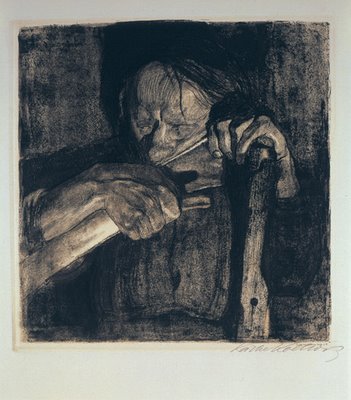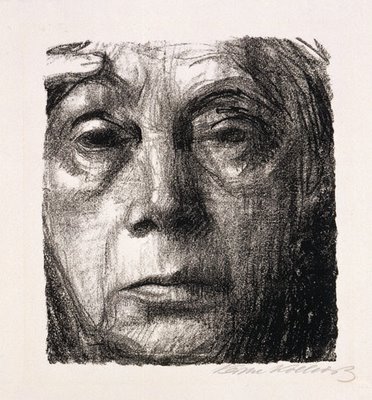Cameron Jamie

Cameron Jamie’s legend precedes him – like the tale of when he wrestled “Michael Jackson.” As the story goes, back in the mid-‘90s, Jamie often spent his lunch hour outside the Hollywood Wax Museum watching a Michael Jackson impersonator until one day Jamie asked him, “Hey, you want to wrestle.” And “Michael Jackson” said, “Sure.”
“Honest to God,” Jamie insisted when he told me about it recently at MIT’s List Visual Art Center, where the 37-year-old’s first American museum retrospective, organized by Minneapolis’ Walker Art Center, is on view through July 8. I reviewed the exhibit this week (recommended); here I’ll focus more on Jamie’s background.
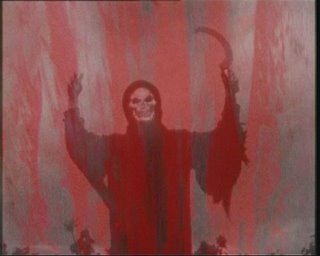 Jamie’s work often takes the form of documents of dark underground middle class rituals, the weird messy stuff churning below our neat social veneer. In his 1996 video “The New Life,” he and the Jackson impersonator wrestle in Jamie’s Los Angeles apartment. Jamie resembles a scrawny version of Leatherface from The Texas Chainsaw Massacre, wearing longjohns, a rubber novelty butt, and a creepy self-portrait mask that he commissioned from a wrestling-mask maker in Mexico. Punctuated by Jackson’s trademark squeals, their grappling, grunting, and panting has a sexual air. It nails our craving for connection with pop celebrities and the wondrous strangeness of “Wacko Jacko.” Underneath lurk questions of how we forge our identities — Jamie with his masked shenanigans, Jackson with surgery, and the look-alike impersonator with his act. Jamie recalls, “I asked him, ‘So is this like the weirdest thing you’ve ever done?’ He said, ‘No, not at all. I once had to do a striptease for a rich Saudi Arabian oil tycoon.’ ”
Jamie’s work often takes the form of documents of dark underground middle class rituals, the weird messy stuff churning below our neat social veneer. In his 1996 video “The New Life,” he and the Jackson impersonator wrestle in Jamie’s Los Angeles apartment. Jamie resembles a scrawny version of Leatherface from The Texas Chainsaw Massacre, wearing longjohns, a rubber novelty butt, and a creepy self-portrait mask that he commissioned from a wrestling-mask maker in Mexico. Punctuated by Jackson’s trademark squeals, their grappling, grunting, and panting has a sexual air. It nails our craving for connection with pop celebrities and the wondrous strangeness of “Wacko Jacko.” Underneath lurk questions of how we forge our identities — Jamie with his masked shenanigans, Jackson with surgery, and the look-alike impersonator with his act. Jamie recalls, “I asked him, ‘So is this like the weirdest thing you’ve ever done?’ He said, ‘No, not at all. I once had to do a striptease for a rich Saudi Arabian oil tycoon.’ ”Jamie is a lanky guy with a chin full of black stubble and wavy dark brown hair cut long like a ‘60s psychedelic rocker. When we chatted at MIT on May 1, he was dressed all in black save for blue denim coat. He has the enthusiasms and expertise of a hipster geek connoisseur of trash culture, and the corresponding revulsions at the vapid entertainment stuff usually plastered across the covers of pop culture magazines.
He grew up in Northridge, about 25 miles northwest of Los Angeles in California’s San Fernando Valley, shuttling back and forth between his divorced parents. Mostly he hung out in his bedroom playing records and drawing. “Music was like my salvation growing up. … Music was like what kept me going,” Jamie tells me. As a teenager, he began photographing spook houses. “No one seemed to acknowledge or think much of those places outside of frame work of Halloween culture,” Jamie says. Here at the uncharted fringes of pop culture, in horror movies, amateur haunted houses, wrestling, rock and roll and underground comics, Jamie he found kindred spirits and inspiration.
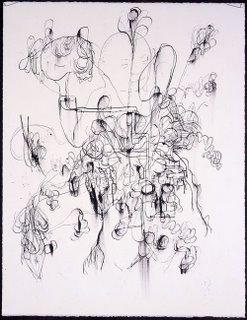 As a teenager, he ingratiated himself to oddball adults like “The Simpsons” creator Matt Groening and punk cartoonist Gary Panter. He met Groening when he arranged to interview the “Life in Hell” cartoonist for a report for his high school newspaper, which never was published – Jamie says, “They wouldn’t publish it because it had ‘hell’ in it.” And he was impressed with Panter’s comic “The Asshole,” saying: “To me one of the biggest artistic influences on me was the fact that a crude comic book like ‘The Asshole’ existed.” (Above, "Snacks for a Ventriloquist," 2005, ink on paper mounted to wood.)
As a teenager, he ingratiated himself to oddball adults like “The Simpsons” creator Matt Groening and punk cartoonist Gary Panter. He met Groening when he arranged to interview the “Life in Hell” cartoonist for a report for his high school newspaper, which never was published – Jamie says, “They wouldn’t publish it because it had ‘hell’ in it.” And he was impressed with Panter’s comic “The Asshole,” saying: “To me one of the biggest artistic influences on me was the fact that a crude comic book like ‘The Asshole’ existed.” (Above, "Snacks for a Ventriloquist," 2005, ink on paper mounted to wood.)Jamie says he met the flamboyantly ghoulish R&B singer Screaming Jay Hawkins by showing up early for his concert with gifts of a rubber snake and a shriveled up apple “head” that he’d made with his Vincent Price Shrunken Head Apple Sculpture kit. “That’s how I got into the show, because they were 21 and over bars. I carried in equipment. I was like a roadie. That changed my life,” Jamie says. “Seeing Screaming Jay Hawkins coming out of a coffin to perform looked like the greatest job in the world.”
Jamie says he similarly befriended Sun Ra, who performed free jazz dressed in a combo of Egyptian and space garb. “He really taught me a lot about doing my own thing, to always follow my own direction and instinct. That no one is going to make your vision happen, and you just have to do things on your own,” Jamie says. “I was really amazed that band like that could even exist on this planet. …. He was an absolute huge influence on me with his philosophy.”
Jamie was dumpster diving all over LA and the San Fernando Valley in the late ‘80s, digging treasures out of school dumpsters. “When I was in junior high I was kind of studying junior high kids because their book reports and notebook journals were so funny and absurd,” Jamie says.
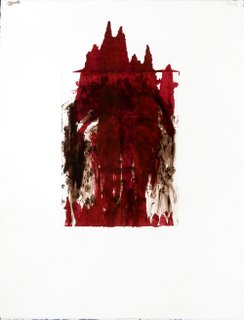 Jamie attended a public high school in Reseda, California, and beginning in junior high spent his summers working in a used record store. “I didn’t know what I was going to do after high school. Because there was no encouragement for what I was doing. So I thought, ‘I guess I’m going to continue to work at the used record shop and make art.’” Then a high school photography teacher said, “You should go to art school because there’s a lot of weird people who you can connect with.” (Above, "Frozen Ghost," 2001, oil on paper mounted to wood.)
Jamie attended a public high school in Reseda, California, and beginning in junior high spent his summers working in a used record store. “I didn’t know what I was going to do after high school. Because there was no encouragement for what I was doing. So I thought, ‘I guess I’m going to continue to work at the used record shop and make art.’” Then a high school photography teacher said, “You should go to art school because there’s a lot of weird people who you can connect with.” (Above, "Frozen Ghost," 2001, oil on paper mounted to wood.)He was accepted into Cal Arts, but couldn’t afford to go. But he cobbled together loans and began classes in his early 20s when his father threatened to throw him out if he didn’t got to college, or the military. He was interested in film and music, in trying out equipment he wouldn’t otherwise have access to. But he butted up against the school’s “post-conceptualist” bent. “At the time, it was a very strict and out-dated program. They had rules and there are no rules for anything in my book,” Jamie says.
So he says he hid out in his studio – the first space he had for art-making outside his bedroom – talking to few people and rarely attending class. He was already beginning to exhibit at underground spaces. And he began making “telephone” portraits like “Six Composite Heads” (1987-‘88), in which he commissioned a street artist to draw portraits of papier-mâché heads he had fished out of a school dumpster.
“It was like a game of telephone. I was always interested in urban mythology, when things are completely degraded and distorted, but yet would take on another life and meaning,” Jamie says.
“I was looking particularly for an artist who had problems rendering portraits realistically,” Jamie says. “…All those things that kind of go wrong during the process of art-making is what I elaborate on in my work. Art isn’t any good if it’s too perfect. It doesn’t have any soul. It seems like a lot of contemporary art is so much about being perfect. No one wants to make art with any visions any more. The avant-garde has lost its soul due to bad artists.”
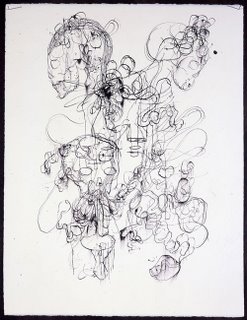 While at CalArts, he worked near Hollywood and Vine, ghost-writing movie reviews. This was when he spent his lunch hour at the nearby Hollywood Wax Museum (his favorite LA museum) watching a Michael Jackson impersonator, whom he later wrestled. (Above, "Wallowing in Pachuco Threads," 2005, ink on paper mounted to wood.)
While at CalArts, he worked near Hollywood and Vine, ghost-writing movie reviews. This was when he spent his lunch hour at the nearby Hollywood Wax Museum (his favorite LA museum) watching a Michael Jackson impersonator, whom he later wrestled. (Above, "Wallowing in Pachuco Threads," 2005, ink on paper mounted to wood.)Jamie says he didn’t show his wrestling videos much, but word got out. Which is how he heard about local teens staging their own wrestling matches in their backyards, a more extreme version of what he’d been doing. “Here I was doing this weird wrestling thing on my own and suddenly here were people in real culture that were doing something similarly weird,” Jamie says. Beginning in 1997, for fun he video taped these contests.
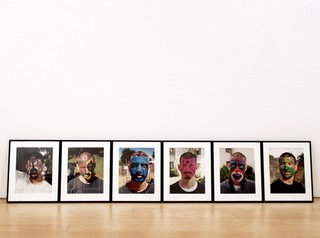 This culminated in his gritty Super 8 film “BB,” 1998-2000 (At top, still from the film; at left, "Studies for BB: Six Portraits," 1998-2000, color photos). Teen boys in masks and painted faces wrestle in a makeshift ring surrounded by one-story bungalows, crashing into each other, leaping off ladders and roofs, bashing each other with metal chairs. “To me the ultimate document of urban primitivism in my work was ‘BB,’” Jamie says. “I realized this is all about ‘primitive’ America.”
This culminated in his gritty Super 8 film “BB,” 1998-2000 (At top, still from the film; at left, "Studies for BB: Six Portraits," 1998-2000, color photos). Teen boys in masks and painted faces wrestle in a makeshift ring surrounded by one-story bungalows, crashing into each other, leaping off ladders and roofs, bashing each other with metal chairs. “To me the ultimate document of urban primitivism in my work was ‘BB,’” Jamie says. “I realized this is all about ‘primitive’ America.”He prefers to screen his videos with live musical accompaniment, loud noise rock meant to overwhelm the audience. “BB” has featured performances by the sludge metal band the Melvins, whom he met when he saw them perform in the early 1990s. They drove the whole crowd out except for the sound guy and him. “Any band who can drive an entire audience out of a club is always a good sign for me,” Jamie says.
In 2000, Jamie moved to France. He’d never lived outside LA before. “The Valley really is nowheresville. It’s sometimes impossible to know where it begins and where it ends.” Particularly dispiriting to him were the Valley’s endless strip malls. “It’s kind of like the end of humanity when you see something like that and it’s why I moved out of America. It’s like a country that’s lost its soul.”
“I also decided to move to France because there were no artists moving there. I wanted to move to a really dead art scene,” Jamie says. He likes old things. He likes quiet. “When I moved to France, it made me like people a lot more. I think I was raised in a very unsocialized environment. … You don’t see the world through your vehicle like you do in L.A.” He adds, “I would never want to move back to the Valley again. I don’t think I’ll ever move back to America. It’s too violent. It’s too intense.”
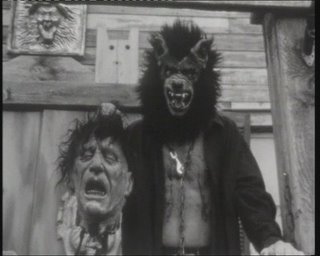
Still, he briefly returned to the LA area in 2002 (or thereabouts) for a project that had him wandering his childhood haunts dressed as Dracula followed by a single witness. And he went to suburban Detroit that fall to film his 2003 video “Spook House” (stills above and second from top), basically a montage of overlapping amateur haunted house skeletons jerking out of coffins, smoke machines, guillotines, electric chairs, flying ghouls, werewolves and demon clowns. A photograph from this project shows a front lawn cemetery with faux tombstones for a fantasy monster and a real-life terrorist. “Now Osama Bin Laden is the new Dracula … They’ll take Osama Bin Laden and include him in a cemetery with other monster characters from popular culture,” Jamie says. “I love the fact that the villainous perception of his image through the eyes of the people in America is seen as though there’s no difference between Dracula, Frankenstein or Osama Bin Laden anymore. They have all reached the same level. And I’m interested in when those things somehow collide, when reality becomes fantasy and fantasy becomes reality.”
“The beautiful thing is people are creating these odd environments entirely themselves,” Jamie says. “The decor of those haunted houses is not my work, it’s somebody else’s work. The way I photographed those places kind of looks like an anonymous photograph, where it doesn’t look too ‘arty.’ … I wanted the viewer to become more intimate with the photos, to go into the pictures somehow, by somehow giving them an authorless quality.”
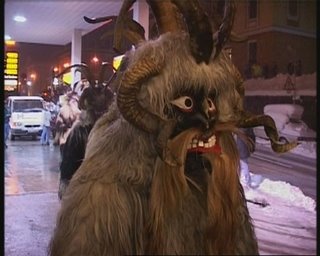 That December, he borrowed a video camera and visited the snowy Austrian village of Bad Hofgastein to document local St. Nicholas feast day traditions. In the 26 minute video “Kranky Klaus," 2002-2003 (above, still from the video), a man playing the saint, dressed in a pope hat and vestments, visits shops and homes giving out bags of chocolate coins. But he’s accompanied by Krampus, a gang of costumed men that look like evil Wookies with goat horns, chains and clanging bell. While St. Nick placidly stands by, the Krampus wrestle shoppers to the snowy ground. They invade homes and meeting halls, overturning tables, throwing boys to the floor, harassing parents, pulling children’s ears.
That December, he borrowed a video camera and visited the snowy Austrian village of Bad Hofgastein to document local St. Nicholas feast day traditions. In the 26 minute video “Kranky Klaus," 2002-2003 (above, still from the video), a man playing the saint, dressed in a pope hat and vestments, visits shops and homes giving out bags of chocolate coins. But he’s accompanied by Krampus, a gang of costumed men that look like evil Wookies with goat horns, chains and clanging bell. While St. Nick placidly stands by, the Krampus wrestle shoppers to the snowy ground. They invade homes and meeting halls, overturning tables, throwing boys to the floor, harassing parents, pulling children’s ears.“The Krampuses actually attacked and pummeled me. They thought I was crazy when I got back up and continued to film and follow them around,” Jamie says. “Santa Claus with the devil handing out gifts … I like that duality, that somehow good and evil work together. Because you can’t have that here in the States. Everything is either black or white.”
Jamie’s most recent video is “JO” (2004). For the full effect check out the screening with Keiji Haino’s live performance of the score at the List on May 17. An exploration of patriotic rituals, it combines footage of a Fourth of July hotdog eating contest in New York with French celebrations of Joan of Arc. The connection between Joan of Arc and eating contests in “JO” relates to the local vernacular in his childhood neighborhood, in which Joan of Arc-style french fries were boiled in oil extra long so they’d be extra crispy.
“I think ‘JO’ is my most violent film,” Jamie says, “especially with the hot dog eating contest. Just the subject matter, the metaphors, the gestures, the eating, the consuming.”
“Cameron Jamie,” MIT List Visual Art Center, 20 Ames St., Cambridge, May 5 to July 8, 2007.
Photos courtesy of the Walker Art Center and MIT.





